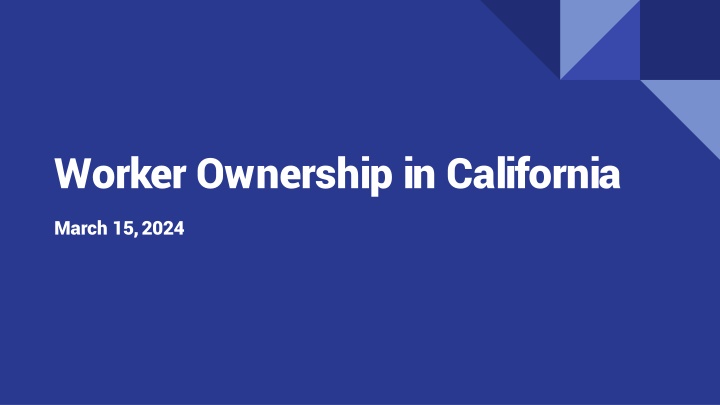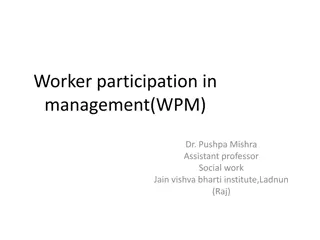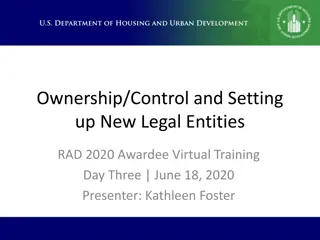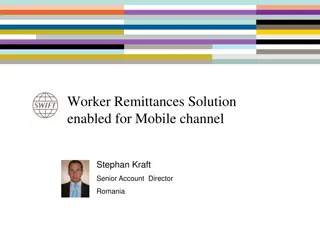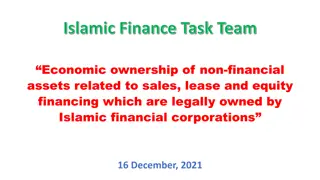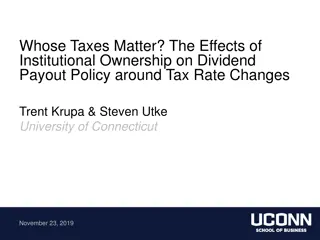Worker Ownership in California: Effects and Research Findings
This report explores the effects of worker ownership in California, including research on job stability, compensation, and productivity. The team of researchers delves into the challenges and successes of worker-owned cooperatives, providing insights into policies and strategies to promote high-road worker co-operatives.
Download Presentation

Please find below an Image/Link to download the presentation.
The content on the website is provided AS IS for your information and personal use only. It may not be sold, licensed, or shared on other websites without obtaining consent from the author.If you encounter any issues during the download, it is possible that the publisher has removed the file from their server.
You are allowed to download the files provided on this website for personal or commercial use, subject to the condition that they are used lawfully. All files are the property of their respective owners.
The content on the website is provided AS IS for your information and personal use only. It may not be sold, licensed, or shared on other websites without obtaining consent from the author.
E N D
Presentation Transcript
Worker Ownership in California March 15, 2024
Report Chapters Supporting research (Appendices) Case study of road construction Case study pair of home health care Mini-cases of co-ops of labor contractors Statistical study Key informant interviews 1. Effects of worker ownership 2. Standards for high-road co-ops 3. Barriers to worker ownership and high-road strategies 4. Factors that promote high-road co- op success 5. Policies to incentivize high-road worker co-operatives 6. Evidence gaps & learning agenda
Team, in brief David Levine, UC Berkeley, Principal Investigator Doug Hirsch, UC Berkeley, Project Manager Daniel Spitzberg, UC Berkeley, Researcher & Chief Editor Adria Scharf, Rutgers School of Management and Labor Relations, Researcher & expert adviser Doug Kruse, Rutgers SMLR, Expert adviser William Foley, Rutgers SMLR, Researcher on lit review K. MacKenzie Scott, MIT Sloan, Researcher on case studies Goncalo Costa, City University of New York, Researcher on statistics Minsun Ji, Rocky Mountain Employee Ownership Center (Exec. Dir.), Researcher on case studies Ed Carberry, University of Massachusetts-Boston, Consulting adviser
Research is hard No randomized experiments Correlation does not equal causation implies that comparing average outcomes can be misleading For example, if we see a relatively low wage at a co-op, it could indicate low pay (for that sort of worker), or could be a relatively high wages in a low-wage sector, or high wages for workers with a low market wage
Results for employees Jobs last longer especially during recessions and COVID Pay is not lower for ESOPs Unclear for co-ops ESOPs help build wealth
Results for employers Employee owned companies survive longer Productivity is often higher, but results are less consistent
Effects of ownership in low-wage sectors? Very little statistical evidence on disadvantaged workers: people of color, with limited education, in low-wage sectors, etc. We are distilling the case study literature
Missing important outcomes Very limited evidence on dignity, respect, harassment, etc. These issues are especially salient in low-wage sectors
Depts. of Labor & Commerce on What is a good job? Recruitment is fair Pay is a stable and equitable living wage, with rewards for skills & experience Benefits are good: Health insurance, retirement, etc. Careers opportunities both at this employer and elsewhere Workers Are empowered at work (strategy, mid-level decisions, shopfloor) Can join unions Are treated with respect Have equal opportunity, without facing discrimination Have schedules with adequate and predictable hours Are safe at work
Depts. of Labor & Commerce on What is a good job? Recruitment is fair Pay is a stable and equitable living wage, with rewards for skills & experience Benefits are good: Health insurance, retirement, etc. Careers opportunities both at this employer and elsewhere Workers Are empowered at work (strategy, mid-level decisions, shopfloor) Right to join unions Are treated with dignity and respect Have equal opportunity, without facing discrimination Have schedules with adequate and predictable hours Are safe at work Bold items are easier to measure
Hard to measure key ideas such as employee empowerment Shopfloor Intermediate levels: Safety committee, grievance procedure Strategic: Board of directors, etc. One person one vote is measurable for strategic participation But misses shopfloor participation
Wages are easier to measure Rules for minimum and maximum compensation face market considerations Why raise minimum wage > market or regulated level? Employees get vote themselves a profit share if a low base wage leaves a surplus
Our research: Snapshot of progress Case study of road construction Case study pair of home health care Mini-cases of co-ops of labor contractors Statistical study Key informant interviews
Case study pair: Home care cooperative
Status We have completed most interviews and observation at a home care cooperative and a comparison similar worker population, geography, and number & type of clients. Both firms are made up of majority immigrant workers from the Philippines, predominantly women
INITIAL OBSERVATIONS: NETWORKS Cooperative is highly networked with significant institutional support Grants from public and philanthropic sources Technical assistance from non-profits and other co-ops Engaged in multiple networks of organizations in worker ownership and in home care organizing and advocacy. The family-owned comparison had some public training and support, with limited access to funding
IMMIGRANTS ARE INTERESTED IN COOPS Immigrant workers make up most of the home care sector. Immigrant workers are particularly vulnerable to wage theft, exploitative work conditions, etc. Many of the Filipina immigrants are also familiar with co-ops from the Philippines This co-op is part of a coalition of cooperatives with immigrants from different global regions (e.g. Africa and non-U.S. Americas)
Competing with informal and noncompliant actors. Both firms spoke of the role of the informal sector and norms of wage theft as challenges to competing as a compliant, high-road business Both firms serve clients who pay for their own care. Requires substantial private resources and/or private long-term care insurance Clients have affordability challenges
Dispersed workforce: Opportunity and challenge It is a challenge to create solidarity, perceptions of shared ownership, and democracy when the workforce is dispersed Complex schedules (e.g. night shifts) complicate scheduling meetings and even virtual engagement At the same time, worker autonomy from dispersion means that worker-owners directly impact care quality
ASHAs and 400 households Case study Road Construction
Status Completed Most (over 20 hours) management and employee interviews Observation of meetings, strategic planning, and on-the- ground work deployment (3-week field visit period) BUT Not yet identified a comparison employer
INITIAL OBSERVATIONS Strong career opportunity within the firm. The ESOP tends to train and promote from within, including for executive positions. Non-college graduates find alternative paths to skills. Management training and building ownership culture. This firm has devoted significant resources to developing shared firm culture and managerial training program that emphasize individual ownership and co-ownership of the firm, as well as autonomy for workers at all levels.
Data collection Co-op conversion of a bakery Retiring owner wanted to benefit employees by selling to them $1.7 million valuation, but owner sold for $1.4 million 7 interviews completed Data analysis is ongoing
Preliminary insights Workers appreciated conversion Strong ownership culture within 2 years Worker-owners flourished after conversion 10 initial employee owners Now 25 full-time employee owners Store revenue more than tripled (!)
Mini-Cases of Co-ops of Labor Contractors
Data collection These mini-cases are at employee-owned contractors No comparisons No employee interviews Goal is to inform our analysis of the proposed Association of Cooperatives of Labor Contractors (ACLC) Mostly using documents
Sample An employee-owned trust to act as a contractor for farmworkers 2 interviews A worker-owned cooperative of health care contractors (everyone but doctors and nurses) One interview
Farmworkers is a trust for employees benefit ESOP Employee Owned Trust Company buys shares for worker retirement accounts Trust keeps shares Company buys back shares when workers leave No Big tax advantages No High costs to set up and operate Much lower costs Can dissolve or sell to a traditional employer Not easily
Ag worker contractor After 1000 hours, employee contractors can join the trust and vote for its board Leadership frustrated at challenges engaging the dispersed migrant workers In early 2024, no employee board members (though rules state 5 employees of 9 board members) Lots of employees have temporary work permits so cannot become owners Started with a big farm partner as main customer 11 smaller clients, but still mostly just supplying their partner client
Health care contractor Not gaining market share After a couple of years, only about a dozen employee- owners Some contractors get hired away by customers
Early insights: Getting started Many partners involved in funding and supporting each contractor
Early insights: Growing When pay is > market level, it is hard to grow market share Unless productivity rises It is useful to have a big customer (that is, someone to hire your contractors) E.g., a big farm to hire farm workers at better-than-normal wages Government support can fill some $gaps COVID-related funding helped one Contractor for a while
Members & migrants Many low-wage employees in farmwork, etc., have a temporary work visa Not a good fit for employee ownership Works better for Employee Ownership Trust than ESOP
Goals Understand how existing organizations and networks support worker ownership and high-road employment Get insights into barriers and potential policies
Sample (part-way through) Key informants with programmatic and analytic perspectives 6 co-op staffing firms and employers of record (one in CA closed in 2020) + 6 in co-op associations providing back-office and HR services 6 individuals in academia, think tanks, and funding who have looked at worker ownership and high-road employment
Early insights 1. Lessons from co-ops can evolve definitions of high-road employment This includes hard-to-measure aspects like dignity and respect However, many aspects of workplace democracy are not limited to worker- owned businesses 2. Economies of scale are vital for staffing/back-office service co-ops All US firms struggle to secure clients and place workers However, several large-scale worker-owned co-ops have demonstrated success through network and ecosystem strategies: Namaste Solar is a vertically integrated supply chain of allied firms Mondragon is a conglomerate of cooperative businesses SEWA is a union of informal workers in India
The question What are the effects of ownership on employees? Are those effects different for disadvantaged employees?
Datasets We are looking at the only 2 datasets we could find 1. General Social Survey a. Three waves had a worker ownership module 2. Rutgers ESOP survey and matched online (Amazon M- Turk) sample
Statistical methods Many potential control variables Employee demographics Employer characteristics Etc. We use a machine learning method to identify important control variables Lots of outcomes, so about 1/20 test will be statistically significant at the 5% level. We adjust for having multiple tests We still worry about searching for results we expect or prefer We are testing specifications with simulated ownership and registering our final specification before we run it
Disadvantaged ESOP members are scarce In GSS (3 waves) In Rutgers Survey Bottom 30% earnings 12 153 Black 10 10 Hispanic 14 21 Immigrant 13 . High school dropout 3 5 Any of above 36 179 Any ESOP 80 (out of 892) 817 (out of 1680)
Rutgers survey has more Disadvantaged ESOP members are scarce ESOP members than GSS, but at only 8 In GSS (3 waves) In Rutgers Survey employers Bottom 30% earnings 12 153 Black 10 10 Hispanic 14 21 Immigrant 13 . High school dropout 3 5 Any of above 36 179 Any ESOP 80 (out of 892) 817 (out of 1680)
A peek at preliminary results Not enough employee owners in the GSS to look at results for disadvantaged employees separately These cross-tabs do not account for observable differences among employers or employees multiple hypothesis testing multiple employees at one ESOP employer in the Rutgers dataset
GSS, scaled 1 to 10 (best) Non-ESOP ESOP mean Difference Satisfaction and pride about company index 7.43 7.86 -0.43 I take part in decision-making 7.00 8.42 1.42*** I have freedom to do my job 7.71 7.74 -0.04 Good relation with management 7.14 7.34 -0.19 My earnings are fair 6.15 5.78 0.37 I am searching for a new job 2.91 2.23 -0.68 7.38 7.66 0.38 I am treated with respect My coworkers care about me 2.95 2.27 0.38 N 692 to 725 73 to 74
Non-ESOP mean ESOP mean Rutgers, bottom 30% of income Difference Satisfaction and pride about company index 6.52 8.24 1.72*** I take part in decision-making 6.60 7.10 0.50 I have freedom to do my job 7.22 7.50 0.28 Good relation with management 3.76 3.01 -0.75 My earnings are fair 4.45 4.95 0.51 I am searching for a new job (10=agree) 3.61 2.02 -1.59*** 151 to 153 N 418
Barriers to employee ownership and high-road strategies
